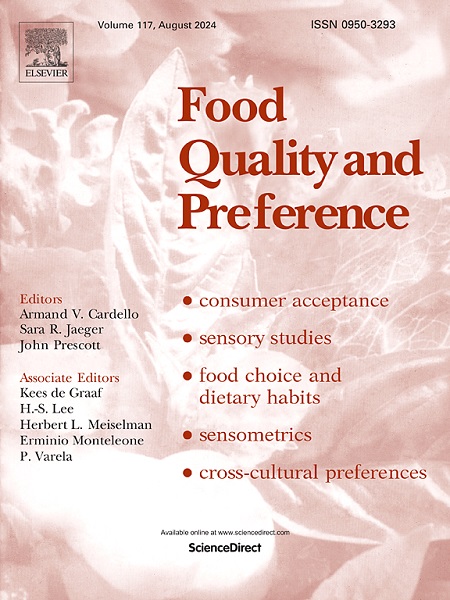Dissociating sensory and decision processes in tasting: Intensity affects sensitivity, while expectancies and feedback interact, affecting decision criteria
IF 4.9
1区 农林科学
Q1 FOOD SCIENCE & TECHNOLOGY
引用次数: 0
Abstract
The aim of this study was to examine the influence of feedback on the dynamics of sensory and decision processes in a tasting task involving mixtures of salty and sour basic tastes. The Double Dissociation Additive Test within the Signal Detection Theory framework was applied to assess the effects of manipulating intensity, signal-noise base rates, and feedback on sensitivity and decision-making processes. Participants' discrimination improved as salt concentration increased, regardless of induced bias or feedback presence; however, feedback led to a general increase in sensitivity. Both signal-noise stimulus base rates and feedback influenced the decision-making process. When feedback was present, detection judgments aligned more closely with actual signal-noise stimulus base rates. However, in the absence of feedback, the relationship between base rates and response bias reversed. Implications for research in sensory evaluation and perceptual learning are discussed.

在品尝中分离感官和决策过程:强度影响敏感性,而期望和反馈相互作用,影响决策标准
本研究的目的是检查反馈对品尝任务中涉及咸和酸混合基本口味的感官和决策过程的动态影响。应用信号检测理论框架内的双重解离加性测试来评估操纵强度、信噪基率和反馈对灵敏度和决策过程的影响。受试者的辨别能力随着盐浓度的增加而提高,与诱导偏差或反馈存在无关;然而,反馈导致了灵敏度的普遍提高。信噪刺激基准利率和反馈都影响决策过程。当反馈存在时,检测判断与实际的信噪刺激基准率更接近。然而,在没有反馈的情况下,基本利率和反应偏差之间的关系发生了逆转。讨论了感官评价和知觉学习研究的意义。
本文章由计算机程序翻译,如有差异,请以英文原文为准。
求助全文
约1分钟内获得全文
求助全文
来源期刊

Food Quality and Preference
工程技术-食品科技
CiteScore
10.40
自引率
15.10%
发文量
263
审稿时长
38 days
期刊介绍:
Food Quality and Preference is a journal devoted to sensory, consumer and behavioural research in food and non-food products. It publishes original research, critical reviews, and short communications in sensory and consumer science, and sensometrics. In addition, the journal publishes special invited issues on important timely topics and from relevant conferences. These are aimed at bridging the gap between research and application, bringing together authors and readers in consumer and market research, sensory science, sensometrics and sensory evaluation, nutrition and food choice, as well as food research, product development and sensory quality assurance. Submissions to Food Quality and Preference are limited to papers that include some form of human measurement; papers that are limited to physical/chemical measures or the routine application of sensory, consumer or econometric analysis will not be considered unless they specifically make a novel scientific contribution in line with the journal''s coverage as outlined below.
 求助内容:
求助内容: 应助结果提醒方式:
应助结果提醒方式:


